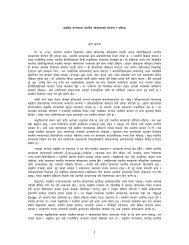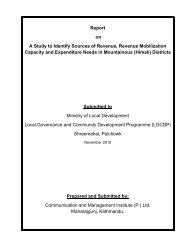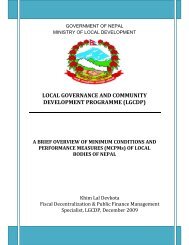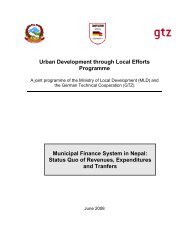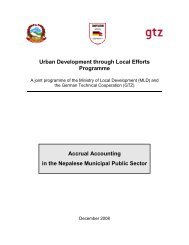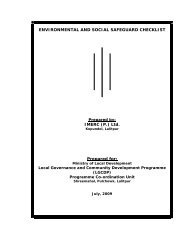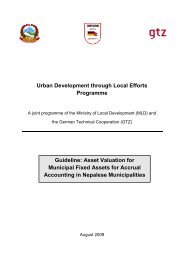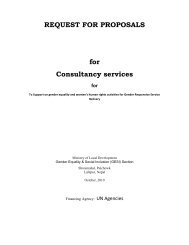GTZ Report on Proposal for Nepal Grant Formula - LGCDP
GTZ Report on Proposal for Nepal Grant Formula - LGCDP
GTZ Report on Proposal for Nepal Grant Formula - LGCDP
Create successful ePaper yourself
Turn your PDF publications into a flip-book with our unique Google optimized e-Paper software.
Urban Development through Local Ef<strong>for</strong>ts ProgrammeA joint programme of the Ministry of Local Development (MLD) andthe German Technical Cooperati<strong>on</strong> (<str<strong>on</strong>g>GTZ</str<strong>on</strong>g>) <strong>Proposal</strong> <strong>for</strong> a new localgovernment taxati<strong>on</strong> systemand intergovernmentaltransfersDecember 2009
<str<strong>on</strong>g>Report</str<strong>on</strong>g> submitted by Dr Alexander Wegener,interpublic c<strong>on</strong>sultancy,Alexander.Wegener@interpublic-c<strong>on</strong>sultancy<strong>on</strong> behalf of <str<strong>on</strong>g>GTZ</str<strong>on</strong>g> <strong>for</strong> <str<strong>on</strong>g>GTZ</str<strong>on</strong>g>/udle
<strong>Proposal</strong> <strong>for</strong> a municipal grant allocati<strong>on</strong> <strong>for</strong>mulaiTable of C<strong>on</strong>tent1 Prec<strong>on</strong>diti<strong>on</strong>s <strong>for</strong> and assumpti<strong>on</strong>s <strong>on</strong> a local government system in a federal <strong>Nepal</strong>.............................................................................................................................................11.1 Principle of subsidiarity and c<strong>on</strong>gruence...............................................................................................................21.2 Principle of equivalence................................................................................................................................................31.3 Principle of c<strong>on</strong>nectivity...............................................................................................................................................32 <strong>Proposal</strong> <strong>for</strong> a new local government taxati<strong>on</strong> system in a federal <strong>Nepal</strong>.............52.1 Replacement of the Local Development Fee.........................................................................................................52.2 A local taxati<strong>on</strong> system acknowledging the design principles of c<strong>on</strong>gruence, equivalence and c<strong>on</strong>nectivity...............................................................................................................................................................................62.2.1 An optimal set of local government taxes.....................................................................................................72.2.2 A reas<strong>on</strong>able sharing of taxes between levels of government..............................................................92.2.3 A cost-‐recovery approach in the calculati<strong>on</strong> of user charges............................................................103 <strong>Proposal</strong> <strong>for</strong> a future grant allocati<strong>on</strong> scheme <strong>for</strong> municipalities in a federal <strong>Nepal</strong>...........................................................................................................................................113.1 Total gross fund deoiniti<strong>on</strong>.........................................................................................................................................113.2 Preference <strong>for</strong> unc<strong>on</strong>diti<strong>on</strong>al grants instead of c<strong>on</strong>diti<strong>on</strong>al grants...........................................................123.3 The proposed grants....................................................................................................................................................133.3.1 Unc<strong>on</strong>diti<strong>on</strong>al grants..........................................................................................................................................133.3.2 C<strong>on</strong>diti<strong>on</strong>al grants...............................................................................................................................................134 <strong>Formula</strong>e de[initi<strong>on</strong> <strong>for</strong> unc<strong>on</strong>diti<strong>on</strong>al grants..............................................................154.1 Basic grant <strong>for</strong>mula deoiniti<strong>on</strong>.................................................................................................................................154.1.1 Populati<strong>on</strong>..............................................................................................................................................................154.1.2 Own Source Revenue.........................................................................................................................................164.1.3 Socio-‐ec<strong>on</strong>omic c<strong>on</strong>diti<strong>on</strong>................................................................................................................................174.2 Minimum C<strong>on</strong>diti<strong>on</strong>s and Per<strong>for</strong>mance Measurement <strong>for</strong>mula deoiniti<strong>on</strong>............................................174.2.1 Minimum c<strong>on</strong>diti<strong>on</strong> fuloilment.......................................................................................................................184.2.2 H<strong>on</strong>ouring local per<strong>for</strong>mance........................................................................................................................184.2.3 <strong>Grant</strong> assignments during a oiscal year.......................................................................................................185 <strong>Formula</strong> de[initi<strong>on</strong> <strong>for</strong> c<strong>on</strong>diti<strong>on</strong>al grants (capital investment grants)...............196 References..................................................................................................................................20
<strong>Proposal</strong> <strong>for</strong> a municipal grant allocati<strong>on</strong> <strong>for</strong>mulaiiList of [igures and tablesFigure 1: Instituti<strong>on</strong>al symmetry in local government oinance...................................................................................4Figure 2: The importance of LDF in the past oiscal years <strong>for</strong> municipalities in <strong>Nepal</strong>.......................................6Figure 3: Revenue types and design criteria......................................................................................................................7Figure 4: The grant allocati<strong>on</strong> scheme...............................................................................................................................14Figure 5: Unit cost of service delivery in dependency to populati<strong>on</strong>.....................................................................16
<strong>Proposal</strong> <strong>for</strong> a municipal grant allocati<strong>on</strong> <strong>for</strong>mula 1Prec<strong>on</strong>diti<strong>on</strong>s <strong>for</strong> and assumpti<strong>on</strong>s <strong>on</strong> a local government system in a federal <strong>Nepal</strong>1 Prec<strong>on</strong>diti<strong>on</strong>s <strong>for</strong> and assumpti<strong>on</strong>s <strong>on</strong> a local government system in a federal <strong>Nepal</strong>This report <strong>on</strong> behalf of gtz/udle aims to open the discussi<strong>on</strong> <strong>on</strong> a future local government oinance sys-tem. The current system of local government oinance has to be changed <strong>for</strong> a number of reas<strong>on</strong>s:• First, <strong>Nepal</strong>'s accessi<strong>on</strong> to the World Trade Organisati<strong>on</strong> requires the abolishment of taxes that dis-criminate imports. The main source of income <strong>for</strong> municipalities in <strong>Nepal</strong> is the Local Development Fee, which needs to be replaced until 2011.• Sec<strong>on</strong>d, <strong>Nepal</strong>'s development towards a federal system will create a new level between local govern-ment and the federal government, and thus, the local government oinance system will have to reolect the new state restructuring.• Third, the current system of local government funding is based predominantly <strong>on</strong> a high share of federal support. However, a decentralised system would require str<strong>on</strong>g local governments – not <strong>on</strong>ly legally, but also oinancially – to balance the idea of local self-‐governance (legal aut<strong>on</strong>omy) with oiscal aut<strong>on</strong>omy.The design of a local revenue system includes three central dimensi<strong>on</strong>s: the assignment of revenue sources am<strong>on</strong>g types of government, the degree of aut<strong>on</strong>omy with which subnati<strong>on</strong>al governments can exercise their assigned authority, and the efoiciency of the revenue administrati<strong>on</strong> system (Taliercio 2006, 107). This paper describes the design of a system of local government oinance in a future federal <strong>Nepal</strong> c<strong>on</strong>sidering the legal authority and the assignment of revenues. • First, this chapter outlines key prec<strong>on</strong>diti<strong>on</strong>s and assumpti<strong>on</strong>s of state structuring and the import-ance of the local level within a federal structure. Key assumpti<strong>on</strong>s are the further deepening of local self-governance of local communities, the principle of subsidiarity and the principle of c<strong>on</strong>gruence (chapter 1.1 hereafter), and the principle of equivalence (chapter 1.2 <strong>on</strong> page 3f.) in oinan-cing local services. The principle of c<strong>on</strong>nectivity relates to oiscal relati<strong>on</strong>s between levels of govern-ment, federal, regi<strong>on</strong>al and local (chapter 1.3 <strong>on</strong> page 3f.). Altogether, these assumpti<strong>on</strong>s favor str<strong>on</strong>g local governments within a federal structure. Key reas<strong>on</strong> <strong>for</strong> proposing str<strong>on</strong>g local govern-ments is the empirical evidence from federal states in industrialised and developing countries, in which often the local government level is weakest in relati<strong>on</strong> to the federal and regi<strong>on</strong>al level.• Sec<strong>on</strong>d, the chapter titled <strong>Proposal</strong> <strong>for</strong> a new local government taxati<strong>on</strong> system in a federal <strong>Nepal</strong> <strong>on</strong> page 5f. describes the future funding sources of local government in a federal <strong>Nepal</strong>, taking into ac-count the undisputed end of the Local Development Fee, a centrally collected import tax redistrib-uted to municipalities based <strong>on</strong> a historical municipal revenue source, the octroi. There is currently no single tax source that may replace the yields from the Local Development Fee, there<strong>for</strong>e new sources have to be identioied which should empower local government, but also guide them to en-hanced resp<strong>on</strong>siveness and accountability to the local communities. Shared taxes and supplements to existing n<strong>on</strong>-‐local taxes may fulloil this requirement. Based <strong>on</strong> three principles presented in chapter 1 an optimal set of local government taxes and user charges is presented.• Third, the chapter titled <strong>Proposal</strong> <strong>for</strong> a future grant allocati<strong>on</strong> scheme <strong>for</strong> municipalities in a federal<strong>Nepal</strong> <strong>on</strong> page 11f. outlines the fund olows between levels of government.• Finally, the <strong>for</strong>th and oifth chapter specioically address design questi<strong>on</strong> <strong>on</strong> allocati<strong>on</strong> <strong>for</strong>mulae <strong>for</strong> Dr Alexander Wegener interpublic c<strong>on</strong>sultancywww.interpublic-‐berlin.de
<strong>Proposal</strong> <strong>for</strong> a municipal grant allocati<strong>on</strong> <strong>for</strong>mula 2Prec<strong>on</strong>diti<strong>on</strong>s <strong>for</strong> and assumpti<strong>on</strong>s <strong>on</strong> a local government system in a federal <strong>Nepal</strong>c<strong>on</strong>diti<strong>on</strong>al and unc<strong>on</strong>diti<strong>on</strong>al grants.gtz/udle hopes to support the discussi<strong>on</strong> process <strong>on</strong> a new local government oinance system in a feder-al <strong>Nepal</strong> and welcomes comments <strong>on</strong> this paper.1.1 Principle of subsidiarity and c<strong>on</strong>gruenceIt may be regarded as success of decentralisati<strong>on</strong> ef<strong>for</strong>ts that publicati<strong>on</strong>s not <strong>on</strong>ly refer to local gov-ernment structure and functi<strong>on</strong>s as in the 1970s and 1980s (<strong>for</strong> example Stamp 1986), but also <strong>on</strong> loc-al government oinance since the 1990s, and that local governments are much more important in ser-vice delivery than they were until the 1990s (<strong>for</strong> example Tordorff and Young 1994, Wunsch 2000). Local governments in a federal state may have very different c<strong>on</strong>stituti<strong>on</strong>al, legal and oinancial rights, and often, their positi<strong>on</strong> in a federal state is threatened (Gboyega 1991).The oirst assumpti<strong>on</strong> of this paper is that within a future federal <strong>Nepal</strong>, there is local self-‐governance <strong>for</strong> local communities. Although the precise structure of local units has not been decided yet, the as-sumpti<strong>on</strong> is made that there is a unioied legislati<strong>on</strong> <strong>on</strong> local government that addresses both the cur-rent municipalities and rural communities. The assumpti<strong>on</strong> is that there will be no district councils in the future.Local self-‐governance is the corner st<strong>on</strong>e of a new local governance oinance system:“It is quite plausible to argue that in the matter of service deliveries as well as in local busi-ness development, c<strong>on</strong>trol rights in governance structures should be assigned to people who have the requisite in<strong>for</strong>mati<strong>on</strong> and incentives and at the same time will bear resp<strong>on</strong>s-ibility <strong>for</strong> the (political and ec<strong>on</strong>omic) c<strong>on</strong>sequences of their decisi<strong>on</strong>s. In many situati<strong>on</strong>s, this insight calls <strong>for</strong> more devoluti<strong>on</strong> of power to local authorities and communities” (Bardhan 2002, 202). The principle of subsidiarity encourages local self-‐governance <strong>for</strong> all local affairs.“Until the late 1980s, decentralisati<strong>on</strong> experiments in sub-‐Saharan Africa tended in the majority of states to rein<strong>for</strong>ce central c<strong>on</strong>trol rather than enhance local aut<strong>on</strong>omy” (Tor-dorff 1994, 555). Key less<strong>on</strong> from decentralisati<strong>on</strong> re<strong>for</strong>m in Comm<strong>on</strong>wealth Sub-‐Saharan Africa is “that if representative authorities are to have more than a symbolic development role, they must be strengthened in both stafoing and oinancial resources” (Tordorff 1994, 579). And this is deoinitely true <strong>for</strong> all decentralisati<strong>on</strong> ef<strong>for</strong>ts in any country, regardless whether industrial-ised, developing, or in transiti<strong>on</strong>.“After all, the logic behind decentralizati<strong>on</strong> is not just about weakening the central author-ity, nor is it about preferring local elites to central authority, but it is fundamentally about making governance at the local level more resp<strong>on</strong>sive to the felt needs of the large majority of the populati<strong>on</strong>” (Bardhan 2002, 202). The principle of subsidiarity indicates that <strong>on</strong>ly those services and public functi<strong>on</strong>s should be operated by higher levels of government if the regulati<strong>on</strong>, producti<strong>on</strong> and delivery of these services <strong>on</strong> the local level would result in either very low efoiciency of effectiveness. The principle of c<strong>on</strong>gruence demands Dr Alexander Wegener interpublic c<strong>on</strong>sultancywww.interpublic-‐berlin.de
<strong>Proposal</strong> <strong>for</strong> a municipal grant allocati<strong>on</strong> <strong>for</strong>mula 3Prec<strong>on</strong>diti<strong>on</strong>s <strong>for</strong> and assumpti<strong>on</strong>s <strong>on</strong> a local government system in a federal <strong>Nepal</strong>that a local government body should be resp<strong>on</strong>sible <strong>for</strong> those tasks which are used by or beneoit mostly the local residents in its administrative boundaries. There should be a spatial identity between de-cisi<strong>on</strong>-‐makers and user or beneoiciaries.Together, the principle of subsidiarity embedded within idea of local self-governance and the principle of c<strong>on</strong>gruence should <strong>for</strong>m <strong>on</strong>e key design criteri<strong>on</strong> <strong>for</strong> a future local government [inance system in <strong>Nepal</strong>.1.2 Principle of equivalenceThere is a vast amount of literature <strong>on</strong> public oinance theory, whereby the underlying principles of tax-ati<strong>on</strong> and spending are assumed to be same <strong>for</strong> unitary and federal states (Bhargava 1953).This principle of equivalence demands, that the beneoiciaries of locally produced services should also pay <strong>for</strong> these services. In c<strong>on</strong>sequence, this principle demands that local services should be funded by the local community. This community is set up by natural and legal pers<strong>on</strong>s. By that principle, it be-comes evident, that funding <strong>for</strong> local government should be balanced between all beneoiciaries of the local government, citizens and businesses.There<strong>for</strong>e, a sound local government oinance system must allow and give legal authority to local gov-ernment bodies to have, set and change taxes, whereby the taxes should comply with the principle of equivalence, and where necessary, to group-‐related equivalence.In a developing country c<strong>on</strong>text, local taxati<strong>on</strong> should also take into account the ability to pay espe-cially of the poor or potentially marginalised groups. One larger attempt to tax all individuals within a local government unit was undertaken in the late 1980s in the United Kingdom. The so-‐called “poll tax” would have meant that every citizen regardless of income would have to fund the local government services. Str<strong>on</strong>g oppositi<strong>on</strong>, and the apparent inequalities created if no other funding sources are avail-able not <strong>on</strong>ly led that the Government gave up the plan, but also ended the political career of Prime Minister Margaret Thatcher. In most countries, group-‐related equivalence is used to legitimate taxes such as• local taxes <strong>on</strong> land and buildings, and• local taxes <strong>on</strong> businesses.It is important that local taxes have broader tax bases covering all most of potential and active users of local government infrastructure and services. Local government tax bases should comprise natural and legal pers<strong>on</strong>s (citizens and businesses) that actually or potentially bene[it from local government infrastructure and services.1.3 Principle of c<strong>on</strong>nectivityThis principle demands, that decisi<strong>on</strong>-‐makers that decide <strong>on</strong> an issue that affects budgets should also be resp<strong>on</strong>sible to fund this decisi<strong>on</strong> by their own means. For example, a federal government should not decide <strong>on</strong> a law which incurs costs <strong>on</strong> sub-‐nati<strong>on</strong>al governments without accompanying funding.Dr Alexander Wegener interpublic c<strong>on</strong>sultancywww.interpublic-‐berlin.de
<strong>Proposal</strong> <strong>for</strong> a municipal grant allocati<strong>on</strong> <strong>for</strong>mula 4Prec<strong>on</strong>diti<strong>on</strong>s <strong>for</strong> and assumpti<strong>on</strong>s <strong>on</strong> a local government system in a federal <strong>Nepal</strong>The principle of c<strong>on</strong>nectivity is more important <strong>for</strong> the design of a local government oinance system in general, and c<strong>on</strong>tributes little to the actual design of local taxes and tariffs. Figure 1: Instituti<strong>on</strong>al symmetry in local government [inanceDecisi<strong>on</strong>-MakersPrinciple of c<strong>on</strong>gruencePrinciple of c<strong>on</strong>nectivityInstituti<strong>on</strong>al SymmetryBeneficiaries, UsersResp<strong>on</strong>sible funding bodyPrinciple of fiscal equivalanceDr Alexander Wegener interpublic c<strong>on</strong>sultancywww.interpublic-‐berlin.de
<strong>Proposal</strong> <strong>for</strong> a municipal grant allocati<strong>on</strong> <strong>for</strong>mula 5<strong>Proposal</strong> <strong>for</strong> a new local government taxati<strong>on</strong> system in a federal <strong>Nepal</strong>2 <strong>Proposal</strong> <strong>for</strong> a new local government taxati<strong>on</strong> system in a federal <strong>Nepal</strong>This chapter deals with opti<strong>on</strong>s <strong>on</strong> how to redesign the local taxati<strong>on</strong> system in <strong>Nepal</strong> under two major changes that will affect local government:• First, the secti<strong>on</strong> 2.1 <strong>on</strong> “Replacement of the Local Development Fee“ shows the major implicati<strong>on</strong> <strong>on</strong> municipal oinance in <strong>Nepal</strong> if the LDF is being abolished, • Sec<strong>on</strong>d, secti<strong>on</strong> 2.2 titled “A local taxati<strong>on</strong> system acknowledging the design principles of c<strong>on</strong>gru-ence, equivalence and c<strong>on</strong>nectivity“ outlines the key principles after which a local taxati<strong>on</strong> system should be designed.• Sub-‐secti<strong>on</strong> 2.2.1 titled “An optimal set of local government taxes“ applies the principles to taxes typically assigned to local governments,• Sub-‐secti<strong>on</strong> 2.2.2 titled “A reas<strong>on</strong>able sharing of taxes between levels of government“ discusses the need to tax sharing arrangements in a federal structure, and• Sub-‐secti<strong>on</strong> 2.2.3 titled “A cost-‐recovery approach in the calculati<strong>on</strong> of user charges“ determines the key design criteria <strong>for</strong> the calculati<strong>on</strong> of prices <strong>for</strong> user charges and fees.The opti<strong>on</strong>s discussed are based <strong>on</strong> Public Finance Theory and experiences in federal states such as Germany, Austria, Switzerland, and others. 2.1 Replacement of the Local Development FeeThe Local Development Fee (LDF) plays a major role in local government funding in <strong>Nepal</strong> <strong>for</strong> the mu-nicipalities. The LDF' predecessor, the octroi, was replaced by a centrally collected import duty and has been redistributed to the municipalities. However, the <strong>for</strong>mulae <strong>for</strong> the allocati<strong>on</strong> is based <strong>on</strong> previous octroi collecti<strong>on</strong>, and although modioied – guaranteeing minimum amounts to all municipalities – the LDF is far bey<strong>on</strong>d a fair distributi<strong>on</strong>. The LDF is regarded as “own source revenue”, although the LDF in practice is more similar to an unc<strong>on</strong>-diti<strong>on</strong>al grant without a clear <strong>for</strong>mula. Dr Alexander Wegener interpublic c<strong>on</strong>sultancywww.interpublic-‐berlin.de
<strong>Proposal</strong> <strong>for</strong> a municipal grant allocati<strong>on</strong> <strong>for</strong>mula 6<strong>Proposal</strong> <strong>for</strong> a new local government taxati<strong>on</strong> system in a federal <strong>Nepal</strong>Figure 2: The importance of LDF in the past [iscal years <strong>for</strong> municipalities in <strong>Nepal</strong>12000000001000000000800000000<strong>Nepal</strong>ese Rupees6000000004000000002000000000FY91/92FY93/93FY93/94FY94/95FY94/96FY96/97FY97/98FY98/99FY99/00FY00/01FY01/02FY02/03FY03/04FY04/05FY05/06Annual BreakdownSince <strong>Nepal</strong>'s ratioicati<strong>on</strong> to accede the World Trade Organisati<strong>on</strong> it is clear that duties have to be abol-ished to foster free markets, and this would in c<strong>on</strong>sequence result in a dramatic oinancial loss of the re-ceiving municipalities. The importance of LDF is extraordinary high (see oigure 2 <strong>on</strong> page 6). Revenue from LDF has been growing <strong>for</strong> years and since some years, around <strong>on</strong>e billi<strong>on</strong> <strong>Nepal</strong>ese Rupees are redistributed to muni-cipalities.The design of a new local government oinance system <strong>for</strong> <strong>Nepal</strong> has thus to oind• alternatives to the LDF – in the amount of roughly <strong>on</strong>e billi<strong>on</strong> <strong>Nepal</strong>ese Rupees, and• to design a local government oinance system in a future federal <strong>Nepal</strong> based <strong>on</strong> the above menti<strong>on</strong>ed principles of c<strong>on</strong>gruence, equivalence and c<strong>on</strong>nectivity.2.2 A local taxati<strong>on</strong> system acknowledging the design principles of c<strong>on</strong>gruence, equivalence and c<strong>on</strong>nectivityAssignment of reas<strong>on</strong>able taxing powers helps give a government c<strong>on</strong>trol over its oiscal destiny. It al-lows the government, acting <strong>for</strong> its citizens, choice over its level of spending and how that spending will be oinanced from segments of its ec<strong>on</strong>omy. That is an important element <strong>for</strong> oiscal aut<strong>on</strong>omy. Dr Alexander Wegener interpublic c<strong>on</strong>sultancywww.interpublic-‐berlin.de
<strong>Proposal</strong> <strong>for</strong> a municipal grant allocati<strong>on</strong> <strong>for</strong>mula 7<strong>Proposal</strong> <strong>for</strong> a new local government taxati<strong>on</strong> system in a federal <strong>Nepal</strong>From the revenue side of the public ec<strong>on</strong>omy, oiscal aut<strong>on</strong>omy (and resp<strong>on</strong>sibility) is greatest when the subnati<strong>on</strong>al government chooses what taxes it will levy, deoines the bases it will use, sets the rate and preference structure <strong>for</strong> those bases, and administers the taxes that have been adopted (Mikesell 2003).Figure 3 <strong>on</strong> page 7 summarises the optimal design of three major types of income <strong>for</strong> local government bodies if the three guiding principles of c<strong>on</strong>gruence, equivalence and c<strong>on</strong>nectivity would be applied to the three main sources of income of local governments:• User charges (usually <strong>for</strong> utilities) and fees (usually <strong>for</strong> administrative services)• Local taxes• <strong>Grant</strong>s.Figure 3: Revenue types and design criteriaSourceFees and user chargesLocal taxes<strong>Grant</strong>sBasisLocal services where the individual c<strong>on</strong>sumpti<strong>on</strong> is measurable and politic-ally desired (such as water, electricity, solid waste collecti<strong>on</strong>, etc.).Local fees and user charges should be designed that the services provided can be founded (full cost recovery).Local services, where the individual c<strong>on</strong>sumpti<strong>on</strong> is either not measurable, or not desirable.Local taxes, however, should follow the principle of equivalence. There<strong>for</strong>e, the principle of equivalence is extended to local groups beneoitting from loc-al services such as house-‐ and land owners, businesses, or citizens.In an ideal world, grants do fuloil two functi<strong>on</strong>s <strong>on</strong>ly: The serve to guarantee a minimum oinancial basis of local bodies (oiscal functi<strong>on</strong>) and to internalise external spatial effects. after Friedrich 2005Based <strong>on</strong> this optimal design, the following sub-‐secti<strong>on</strong>s deal with• An optimal set of local government taxes (secti<strong>on</strong> 2.2.1 <strong>on</strong> page 9f.),• A reas<strong>on</strong>able sharing of taxes between levels of government (secti<strong>on</strong> 2.2.2 <strong>on</strong> page 9f.),• An optimal set of local government taxes (secti<strong>on</strong> 2.2.3 <strong>on</strong> page 10f.).2.2.1 An optimal set of local government taxesProperty taxes are regarded often as an “optimal” local tax, especially when taking into account Anglo-‐Sax<strong>on</strong> literature. However, this type of tax affect <strong>on</strong>ly a specioic group of the local citizenry and not ne-cessarily the whole community. This tax is an example of a group-‐related equivalence, whereby the as-sumpti<strong>on</strong> is made that property owner beneoit in general from local government decisi<strong>on</strong>-‐making and service delivery bey<strong>on</strong>d user-‐charge based service delivery. Dr Alexander Wegener interpublic c<strong>on</strong>sultancywww.interpublic-‐berlin.de
<strong>Proposal</strong> <strong>for</strong> a municipal grant allocati<strong>on</strong> <strong>for</strong>mula 8<strong>Proposal</strong> <strong>for</strong> a new local government taxati<strong>on</strong> system in a federal <strong>Nepal</strong>An optimal set of local government taxes should embrace different groups within the local community. These groups should comprise both citizens and businesses. There<strong>for</strong>e, an optimal set of local government taxes results in at least <strong>on</strong>e tax per group targeting• citizens (local income or property related tax) and • businesses (local business tax)This, in c<strong>on</strong>sequence, would require that local government bodies in the c<strong>on</strong>text of <strong>Nepal</strong> have the legal authority to tax• citizens through the integrated property tax, and to tax• businesses through the business tax.Typically, upper levels of government collect income taxes such as pers<strong>on</strong>al income tax or corporate in-come tax. Business taxes and corporate income tax do often tax the same tax base. To avoid double tax-ati<strong>on</strong>, the amount paid by a local business to the local taxing authority (business tax) must be deduct-ible from the corporate income tax payable to upper levels of government. The number of businesses subject to business tax should be larger than the number of businesses subject to corporate income tax. A local business tax should cover all businesses, small-‐scale and even in<strong>for</strong>mal businesses. In prac-tice, this requires an assessment process that can deal with the in<strong>for</strong>mal sector, too. Tax in<strong>for</strong>mati<strong>on</strong> in this case may even provide very helpful in<strong>for</strong>mati<strong>on</strong> <strong>on</strong> the ec<strong>on</strong>omic development of a community. The amount of high-‐yielding local taxes is limited in most countries of the world. Typically, the follow-ing taxes are the most important to local government funding:• pers<strong>on</strong>al income tax (in Nordic countries <strong>on</strong>ly, Denmark, Sweden, Norway)• land tax <strong>on</strong> unbuilt areas• building tax <strong>on</strong> buit-‐up areas, often land tax and building tax are c<strong>on</strong>nected (Anglo-‐Sax<strong>on</strong> property taxati<strong>on</strong>), and • business taxA surtax system <strong>on</strong> the major nati<strong>on</strong>al taxes, such as income tax (n<strong>on</strong>-‐progressive), is widely used to oinance local budgets from internati<strong>on</strong>al perspectives. Local governments can piggyback extra rates <strong>on</strong> the stable nati<strong>on</strong>al taxes using the same tax base. With the development of local taxes, a surtax system can be applied using the existing tax collecti<strong>on</strong> channel of the General Taxati<strong>on</strong> Department, which will reduce administrative costs. A ceiling should be put <strong>on</strong> surcharge rates to limit the wide difference in surcharge rates am<strong>on</strong>g jurisdicti<strong>on</strong>s. The merit of a surtax system lies in guaranteeing stable revenue resources <strong>for</strong> local governments with fewer administrati<strong>on</strong> ef<strong>for</strong>ts. “In the l<strong>on</strong>ger term, a surcharge or piggy-‐back <strong>on</strong> pers<strong>on</strong>al income taxati<strong>on</strong> is the best op-ti<strong>on</strong>. It would allow subnati<strong>on</strong>al governments to set their own tax rates <strong>on</strong> a centrally deoined tax base and within limits set up by the central government” (Ahmad and Brosio 2008).However, piggybacking has some downfalls, too:“While surcharges <strong>on</strong> central tax bases can give a c<strong>on</strong>siderable degree of oiscal aut<strong>on</strong>omy without some of the problems that full aut<strong>on</strong>omy can create, subnati<strong>on</strong>al governments may not agree, if given the choice, that the aut<strong>on</strong>omy thus given is adequate. In particular, Dr Alexander Wegener interpublic c<strong>on</strong>sultancywww.interpublic-‐berlin.de
<strong>Proposal</strong> <strong>for</strong> a municipal grant allocati<strong>on</strong> <strong>for</strong>mula 9<strong>Proposal</strong> <strong>for</strong> a new local government taxati<strong>on</strong> system in a federal <strong>Nepal</strong>they may be c<strong>on</strong>cerned that a government not receiving the revenue from a tax that it ad-ministers is likely to feel less urgency in collecti<strong>on</strong> of or <strong>for</strong> re<strong>for</strong>m of that tax than are those using the revenue to oinance their operati<strong>on</strong>s. They may feel that administrati<strong>on</strong> in practice is inextricably intertwined with tax policy and that, without having choice over administrative decisi<strong>on</strong>s, they lack appropriate oiscal aut<strong>on</strong>omy” (Mikesell 2003).In the c<strong>on</strong>text of <strong>Nepal</strong>, the number of taxpayers <strong>for</strong> high-‐yielding taxes such as individual or corporate income tax, value-‐added tax or others is still low. However, Government might c<strong>on</strong>sider surcharges to increase the overall revenues from these taxes, as there are still a large number of potential taxpayers de facto “exempted” from tax invoices.2.2.2 A reas<strong>on</strong>able sharing of taxes between levels of governmentThe large importance of the LDF to local government funding in <strong>Nepal</strong> (at the moment limited to muni-cipalities) raises the questi<strong>on</strong> which income might replace the LDF when abolished. It is rather evident that given the relatively large number of revenue titles that are assigned to <strong>Nepal</strong>ese municipalities no single additi<strong>on</strong>al “new” tax can be created to replace the high-‐yielding LDF.An alternative and more efoicient way to equip local governments with revenue is to better exploit the shared revenue between central and local governments. We can expect beneoits of tax sharing such as reduced tax competiti<strong>on</strong> am<strong>on</strong>g local governments, ec<strong>on</strong>omies of scale in tax administrati<strong>on</strong> and collecti<strong>on</strong>, and the maintenance of revenue stability over the business cycle etc. However, there are also downsides of the tax sharing scheme, due to disadvantages such as a reducti<strong>on</strong> in local aut<strong>on</strong>omy and the breaking of the link between the beneoits and costs of local public expenditure (Mikesell 2003).This fact is an argument to broaden the tax bases of the current taxes (see the secti<strong>on</strong> above). However, even with a broadening of the tax bases of the current local taxes in <strong>Nepal</strong> – especially the integrated property tax and the business tax as the potentially most important local taxes in the future – there is a need to replace the current grant allocati<strong>on</strong> scheme and the LDF redistributi<strong>on</strong> through a system of shared taxes.Shared taxes are very comm<strong>on</strong> in federal states. In Germany, <strong>for</strong> example, there are a number of taxes which are shared between the federal level and the state level, and there are provisi<strong>on</strong> that guarantee local governments a share. This is the case <strong>for</strong> the distributi<strong>on</strong> of the value-‐added tax, the pers<strong>on</strong>al in-come tax and tax <strong>on</strong> capital gains. Local governments in Switzerland levy supplements to cant<strong>on</strong> individual income taxes (see Mikesell 2003). Each of the twenty-‐six Swiss cant<strong>on</strong>s has its own tax system and local governments are entitled to levy taxes to the extent authorized by the cant<strong>on</strong>. The communal tax is levied as a percentage or multiple of the basic cant<strong>on</strong> tax rate. A federal law requires cant<strong>on</strong>s to harm<strong>on</strong>ize their income tax c<strong>on</strong>cept and deducti<strong>on</strong>s with the federal base, but they may set the amount of deducti<strong>on</strong>s and their rate schedules. Each of the cant<strong>on</strong>s has a separate administrative body <strong>for</strong> collecti<strong>on</strong> of its taxes. The communal tax is piggybacked <strong>on</strong> the cant<strong>on</strong> tax and federal tax is reported <strong>on</strong> the cant<strong>on</strong> return. Thus, the cant<strong>on</strong> is resp<strong>on</strong>sible <strong>for</strong> assessing and collecting federal, cant<strong>on</strong>, and communal income tax – cent-ralizati<strong>on</strong> down from the cant<strong>on</strong> but decentralized administrati<strong>on</strong> up to the federal level. In c<strong>on</strong>trast to the case in many nati<strong>on</strong>s, subnati<strong>on</strong>al – cant<strong>on</strong> and municipal – Swiss governments receive the bulk of income tax collecti<strong>on</strong>s, not the federal government. And, again in c<strong>on</strong>trast to most internati<strong>on</strong>al exper-ience, the income tax is a relatively modest revenue source <strong>for</strong> the federal level. But because the tax is collected across all cant<strong>on</strong>s, it is important that the base and deducti<strong>on</strong>s be standardized in order that Dr Alexander Wegener interpublic c<strong>on</strong>sultancywww.interpublic-‐berlin.de
<strong>Proposal</strong> <strong>for</strong> a municipal grant allocati<strong>on</strong> <strong>for</strong>mula 10<strong>Proposal</strong> <strong>for</strong> a new local government taxati<strong>on</strong> system in a federal <strong>Nepal</strong>a uni<strong>for</strong>m effective federal rate can be imposed <strong>on</strong> taxpayers without regard to their locati<strong>on</strong>.At the current stage of the discussi<strong>on</strong> process of state restructuring it is not possible to recommend specioic taxes to be shared until there is a decisi<strong>on</strong> <strong>on</strong> task assignment between the federal, the new re-gi<strong>on</strong>al and the existent local level with a high degree of local self-‐governance is taken. However, the future funding mechanism will have to rely <strong>on</strong> shared taxes to meet the funding requirements of the local level, and most probably, tax sharing agreements usually refer to income taxes or taxes <strong>on</strong> c<strong>on</strong>sumpti<strong>on</strong>.There<strong>for</strong>e, an “optimal set” of taxes and fees includes:• a stable and predictable tax revenue source• such as a property tax based <strong>on</strong> land and buildings, if the valuati<strong>on</strong> is kept simple and complies with the standard instituti<strong>on</strong>al capacity of local governments units in <strong>Nepal</strong>.• a tax revenue sensitive to ec<strong>on</strong>omic development• such as a business tax <strong>on</strong> prooits of all business activities (<strong>for</strong>mal and in<strong>for</strong>mal sector, blue-‐collar and white collar, including freelancers, regardless of size and branch of activity) that create in-centives <strong>for</strong> local government units to promote ec<strong>on</strong>omic development within their boundaries. The local business tax <strong>for</strong> businesses already paying corporate taxes should be deductible from the corporate tax.• Such as a local share of pers<strong>on</strong>al income tax <strong>for</strong> all natural pers<strong>on</strong>s• cost recovering user charges <strong>for</strong> fee-based technical services such as water, sewerage, solida waste collecti<strong>on</strong> and other services. Local councils may subsidise fees with general funds, if a full cost recovery approach is not feasible.In additi<strong>on</strong>, the proposed basic grants should be based <strong>on</strong> populati<strong>on</strong> data and thus are encouraging local government units to create housing and job opportunities. The basic grant should be stable and predictable to enable local government oinancial planning.2.2.3 A cost-recovery approach in the calculati<strong>on</strong> of user chargesAlthough user charges are by no means taxes, and typically, user charges are comm<strong>on</strong> <strong>for</strong> services which are c<strong>on</strong>sumed individually or per household and where a pers<strong>on</strong>-‐ or household-‐related charging is appreciated. User charges should not be c<strong>on</strong>sidered as general funds, but specioically aimed to cover the costs of that specioic services, such as water c<strong>on</strong>sumpti<strong>on</strong> and waste water, street cleaning, electri-city c<strong>on</strong>sumpti<strong>on</strong>, abattoir services, and others.The user charges should not exceed the full cost of the service, and the council is due to make political decisi<strong>on</strong>s which services should achieve which level of cost recovery. Any cost recovery below full cost recovery will then require support from the general fund and thus reducing the local possibilities <strong>for</strong> decisi<strong>on</strong>-‐making.Dr Alexander Wegener interpublic c<strong>on</strong>sultancywww.interpublic-‐berlin.de
<strong>Proposal</strong> <strong>for</strong> a municipal grant allocati<strong>on</strong> <strong>for</strong>mula 11<strong>Proposal</strong> <strong>for</strong> a future grant allocati<strong>on</strong> scheme <strong>for</strong> municipalities in a federal <strong>Nepal</strong>3 <strong>Proposal</strong> <strong>for</strong> a future grant allocati<strong>on</strong> scheme <strong>for</strong> municipalities in a federal <strong>Nepal</strong>“We oind that developing countries have more centralized oiscal structures and argue that this is c<strong>on</strong>sistent with the theory of oiscal federalism. Ec<strong>on</strong>omic development, however, does push the advantage toward decentralizati<strong>on</strong>. We also show that developing countries use a wide variety of transfer instruments to fund local governments, and that these in-struments give the nati<strong>on</strong>al government varying degrees of c<strong>on</strong>trol over local government oinances” (Bahl and Linn 1994, 1)Ec<strong>on</strong>omic theory assigns the functi<strong>on</strong>s of general purpose grants to address vertical imbalance between central and local budgets and to adjust horiz<strong>on</strong>tal imbalances am<strong>on</strong>g local budgets. The the-ory also assigns specioic purpose grants to correct spillovers and to implement nati<strong>on</strong>al goals through local expenditure. <strong>Grant</strong> allocati<strong>on</strong> should support local self-‐governance in promoting social, ec<strong>on</strong>omic and democratic progress <strong>on</strong> the local level. <strong>Grant</strong>s are not to be misused to tighten c<strong>on</strong>trol over local government, neither by federal level, nor by regi<strong>on</strong>al level.Regarding the design of equalizati<strong>on</strong> and specioic purpose grants, Bird and Smart (2002) set out the following principles of internati<strong>on</strong>al less<strong>on</strong>s. These are: • Both general purpose and special purpose matching grants should be managed <strong>on</strong> the basis of rules. • The funding pool of general purpose grants should be set in a stable but olexible way. • The allocati<strong>on</strong> of general purpose grants should take account of both need and capacity. The <strong>for</strong>mula should be as simple, reliable, and transparent as possible. • Specioic incentive features to encourage additi<strong>on</strong>al tax ef<strong>for</strong>t are not necessary, if the general pur-pose grants are designed properly and if some tax policy discreti<strong>on</strong> is guaranteed <strong>for</strong> local govern-ments.• On the use of general purpose grants, no c<strong>on</strong>diti<strong>on</strong>s should be imposed. • Matching c<strong>on</strong>diti<strong>on</strong>s according to the expenditure type and oiscal capacity of recipient government should vary in the provisi<strong>on</strong> of specioic purpose grants. • In oinancing infrastructure by specioic purpose grants, recipient governments should satisfy technic-al c<strong>on</strong>diti<strong>on</strong>s, which ensure that m<strong>on</strong>ey is properly spent. • The management of local public oinance of all local governments should follow standard procedures, to maintain adequate and current accounts, and be audited regularly and publicly. 3.1 Total gross fund de[initi<strong>on</strong>In a federal <strong>Nepal</strong>, it is assumed that local government is deoined as <strong>on</strong>e of three state levels next to the federal level and the regi<strong>on</strong>al level. This is necessary to ensure that federal government has a stake in local government oinance. If local government would be regarded as an internal affair of the regi<strong>on</strong>al states, the federal government would possibly violate the c<strong>on</strong>stituti<strong>on</strong> if they would directly address Dr Alexander Wegener interpublic c<strong>on</strong>sultancywww.interpublic-‐berlin.de
<strong>Proposal</strong> <strong>for</strong> a municipal grant allocati<strong>on</strong> <strong>for</strong>mula 12<strong>Proposal</strong> <strong>for</strong> a future grant allocati<strong>on</strong> scheme <strong>for</strong> municipalities in a federal <strong>Nepal</strong>local governments. There<strong>for</strong>e, the gross fund deoiniti<strong>on</strong> <strong>for</strong> funds to be allocated to local governments – here municipalities – should be a fund that should be oilled by the federal government and should be open <strong>for</strong> regi<strong>on</strong>al governments <strong>for</strong> funding, too. There are two opti<strong>on</strong>s• First, all regi<strong>on</strong>s could use the total gross fund as an equalisati<strong>on</strong> element: All regi<strong>on</strong>s pay in accord-ing to a <strong>for</strong>mula to be agreed up<strong>on</strong>, and the funds are distributed across the nati<strong>on</strong>. The funding to a gross fund is an equalisati<strong>on</strong> element, as there might be regi<strong>on</strong>s that pay more in the fund than the municipalities are receiving in that regi<strong>on</strong>. However, this is depending <strong>on</strong> the revenue assignment to the regi<strong>on</strong>s. • Sec<strong>on</strong>d, if regi<strong>on</strong>s are not willing to use the gross fund as an equalisati<strong>on</strong> element, they could top up the federal grant anticipated <strong>for</strong> the municipalities within their regi<strong>on</strong>. What should be avoided and what should be limited by law is a multitude of different funding schemes, different grant allocati<strong>on</strong> schemes that would encourage imbalances in local government funding rather than to create a fair and equal funding opti<strong>on</strong>s <strong>for</strong> all urban areas in <strong>Nepal</strong>.3.2 Preference <strong>for</strong> unc<strong>on</strong>diti<strong>on</strong>al grants instead of c<strong>on</strong>diti<strong>on</strong>al grantsOne key questi<strong>on</strong> is designing local government oinance system is the need <strong>for</strong> federal or regi<strong>on</strong>al fund-ing of local governments in general, and thereafter the questi<strong>on</strong>, whether this federal or regi<strong>on</strong>al fund-ing should be unc<strong>on</strong>diti<strong>on</strong>al or c<strong>on</strong>diti<strong>on</strong>al.In principle, the local government oinance system in a federal state with str<strong>on</strong>g local governments in terms of legal aut<strong>on</strong>omy, oiscal aut<strong>on</strong>omy and relevance <strong>for</strong> the service delivery, should always seek to ensure sufoicient funding from own sources of revenue. As explained above, own sources of revenue are unlikely to be enough to fund <strong>for</strong> all functi<strong>on</strong>s assigned to local governments, there<strong>for</strong>e tax sharing agreements are essential in <strong>Nepal</strong>. However, even with the combinati<strong>on</strong> of own source revenues and shared taxes, oiscal imbalances might occur. Fiscal imbalances are typical <strong>for</strong> those state systems which grant local government oiscal aut<strong>on</strong>omy. The more income of local government is dependent <strong>on</strong> own source revenues, the more likely are imbalances in terms of per capita income, especially in a country with large differences between municipalities in terms of geographical setting and ec<strong>on</strong>omic activity such as <strong>Nepal</strong>.Unc<strong>on</strong>diti<strong>on</strong>al grants do have the functi<strong>on</strong> to guarantee the functi<strong>on</strong> of local government regardless where the local government is located and regardless the socio-‐ec<strong>on</strong>omic c<strong>on</strong>diti<strong>on</strong>. However, unc<strong>on</strong>di-ti<strong>on</strong>al grants may c<strong>on</strong>tain equalizati<strong>on</strong> elements to reduce vertical oiscal imbalances.C<strong>on</strong>diti<strong>on</strong>al grants should be small in number and small in amounts allocated. The main reas<strong>on</strong> is that c<strong>on</strong>diti<strong>on</strong>al grants are designed by deoiniti<strong>on</strong> to support specioic policy objectives of the Government. The Government has – through the instrument of c<strong>on</strong>diti<strong>on</strong>al grants – large opportunities to guide loc-al council decisi<strong>on</strong>s, as c<strong>on</strong>diti<strong>on</strong>al grants reduce the cost of service delivery or capital investments. There is no problem in having c<strong>on</strong>diti<strong>on</strong>al grants, however, there share of unc<strong>on</strong>diti<strong>on</strong>al grants should be much larger to enable local councils to fund local services according to the needs of the local people, while the share of c<strong>on</strong>diti<strong>on</strong>al grants should be much smaller to offer incentives <strong>for</strong> local councils to fund local services according to the political programme of the Government.Dr Alexander Wegener interpublic c<strong>on</strong>sultancywww.interpublic-‐berlin.de
<strong>Proposal</strong> <strong>for</strong> a municipal grant allocati<strong>on</strong> <strong>for</strong>mula 13<strong>Proposal</strong> <strong>for</strong> a future grant allocati<strong>on</strong> scheme <strong>for</strong> municipalities in a federal <strong>Nepal</strong>3.3 The proposed grantsUnc<strong>on</strong>diti<strong>on</strong>al grants should ensure the operati<strong>on</strong> of local government tasks and functi<strong>on</strong>s assigned, if local sources of income are too small or too volatile.C<strong>on</strong>diti<strong>on</strong>al grants should be kept small in number, and may be used to promote federal or regi<strong>on</strong>al policy objectives.3.3.1 Unc<strong>on</strong>diti<strong>on</strong>al grantsThere should be <strong>on</strong>ly <strong>on</strong>e unc<strong>on</strong>diti<strong>on</strong>al grant to be allocated to local government units based <strong>on</strong> com-m<strong>on</strong> criteria, which are available to the Government and ensure an equal distributi<strong>on</strong> according to populati<strong>on</strong>, socio-‐ec<strong>on</strong>omic c<strong>on</strong>diti<strong>on</strong> and should be altered by local government per<strong>for</strong>mance in key areas.3.3.2 C<strong>on</strong>diti<strong>on</strong>al grantsThere may be some selected c<strong>on</strong>diti<strong>on</strong>al grants available to local government. The c<strong>on</strong>diti<strong>on</strong>al grants• must be limited in amount,• must be limited in relati<strong>on</strong> to the amount of the unc<strong>on</strong>diti<strong>on</strong>al grants, not exceeding 20% of the total funds available to local governments,• should not given through the various line ministeries, but• should be channelled through the Ministry of Local Development, the Ministry of Physical Planning or the Town Development Fund.Dr Alexander Wegener interpublic c<strong>on</strong>sultancywww.interpublic-‐berlin.de
<strong>Proposal</strong> <strong>for</strong> a municipal grant allocati<strong>on</strong> <strong>for</strong>mula 14<strong>Proposal</strong> <strong>for</strong> a future grant allocati<strong>on</strong> scheme <strong>for</strong> municipalities in a federal <strong>Nepal</strong>Figure 4: The grant allocati<strong>on</strong> schemeFederal GovernmentRegi<strong>on</strong>al GovernmentsTotal Gross FundUnc<strong>on</strong>diti<strong>on</strong>al <strong>Grant</strong>s(80%)C<strong>on</strong>diti<strong>on</strong>al <strong>Grant</strong>s(20%)Basic <strong>Grant</strong>(50%)MCPM <strong>Grant</strong>(50%)Allocati<strong>on</strong> <strong>Formula</strong>(a) populati<strong>on</strong>(b) area(c) poverty(d) own source revenueAllocati<strong>on</strong> <strong>Formula</strong>(a) supplement or(b) chargeto basic grantAllocati<strong>on</strong> <strong>Formula</strong>(a) by proposal(b) co-funding <strong>on</strong>ly(c) TDF processing(d) technical feasibilityC<strong>on</strong>diti<strong>on</strong>al grants should be used to promote federal (or regi<strong>on</strong>al) policy objectives. C<strong>on</strong>diti<strong>on</strong>al grants are by no means meant to tighten oinancial c<strong>on</strong>trol over local government, they always should either to• fund <strong>for</strong> services provided by local government which under regulatory c<strong>on</strong>trol of the federal gov-ernment or the regi<strong>on</strong>al government, but per<strong>for</strong>med by local government. The underlying assump-ti<strong>on</strong> is the rule of the principle of c<strong>on</strong>nectivity, which states that delegated functi<strong>on</strong>s must not re-main unfunded. Delegated functi<strong>on</strong>s hereby means that the functi<strong>on</strong> is <strong>for</strong>mally assigned to a differ-ent level than the level the assigned functi<strong>on</strong> is actually per<strong>for</strong>med.Dr Alexander Wegener interpublic c<strong>on</strong>sultancywww.interpublic-‐berlin.de
<strong>Proposal</strong> <strong>for</strong> a municipal grant allocati<strong>on</strong> <strong>for</strong>mula 15<strong>Formula</strong>e deoiniti<strong>on</strong> <strong>for</strong> unc<strong>on</strong>diti<strong>on</strong>al grants4 <strong>Formula</strong>e de[initi<strong>on</strong> <strong>for</strong> unc<strong>on</strong>diti<strong>on</strong>al grantsThis chapter outlines the proposed <strong>for</strong>mula deoiniti<strong>on</strong> <strong>for</strong> unc<strong>on</strong>diti<strong>on</strong>al grants, while chapter 5 <strong>on</strong> page 19f. describes the <strong>for</strong>mula to be used <strong>for</strong> c<strong>on</strong>diti<strong>on</strong>al grants. This chapter is structured as follows:• secti<strong>on</strong> 4.1 discusses the Basic grant <strong>for</strong>mula deoiniti<strong>on</strong>, and• secti<strong>on</strong> 4.2 shows the relati<strong>on</strong>s to the Minimum C<strong>on</strong>diti<strong>on</strong>s and Per<strong>for</strong>mance Measurement <strong>for</strong>muladeoiniti<strong>on</strong> (page 17f.).4.1 Basic grant <strong>for</strong>mula de[initi<strong>on</strong>This secti<strong>on</strong> shortly describes the criteria to be used:• Populati<strong>on</strong>• Own Source Revenue• Socio-‐ec<strong>on</strong>omic c<strong>on</strong>diti<strong>on</strong>4.1.1 Populati<strong>on</strong>The basic grant <strong>for</strong>mula deoiniti<strong>on</strong> is kept simple and is mainly based <strong>on</strong> populati<strong>on</strong> data. Populati<strong>on</strong> data is available and reliable, and all basic grant <strong>for</strong>mulae in the world rely <strong>on</strong> populati<strong>on</strong> as a key in-dicator <strong>for</strong> grant allocati<strong>on</strong>. The general assumpti<strong>on</strong> in using populati<strong>on</strong> data is that populati<strong>on</strong> also re-olects the costs of delivering a service to the public. However, some problems have to be addressed:• smaller local governments in terms of populati<strong>on</strong> may require a minimum amount allocated, as there are minimum per unit costs <strong>for</strong> service delivery.• The more densely populated an area is, the less are the per unit costs of service delivery (i.e. water supply, sewerage, and others), while the demand <strong>for</strong> infrastructure may be higher in more densely populated local governments compared to sparsly populated local governments (i.e., less demand <strong>for</strong> piped sewerage systems in sparsly populated local governments as open ditch systems may already satisfy the need, thus meaning that service infrastructure costs may be much lower in sparsely populated local governments compared to agglomerati<strong>on</strong>s).While populati<strong>on</strong> is widely used in the design of intergovernmental oiscal relati<strong>on</strong>s, the design of a pop-ulati<strong>on</strong> based criteri<strong>on</strong> must be more complex if there is a large difference in populati<strong>on</strong> between local government units. This is the case in <strong>Nepal</strong>, where the local governments in the Kathmandu Valley are largest in terms in populati<strong>on</strong>, and they are in additi<strong>on</strong> very close and open further efoiciency gains in service delivery through joint service producti<strong>on</strong>. Thus, the criteri<strong>on</strong> <strong>on</strong> populati<strong>on</strong> should take into account• unit cost c<strong>on</strong>siderati<strong>on</strong>s• demand <strong>for</strong> service is often not linear, but starts with a crucial number of inhabitantsDr Alexander Wegener interpublic c<strong>on</strong>sultancywww.interpublic-‐berlin.de
<strong>Proposal</strong> <strong>for</strong> a municipal grant allocati<strong>on</strong> <strong>for</strong>mula 16<strong>Formula</strong>e deoiniti<strong>on</strong> <strong>for</strong> unc<strong>on</strong>diti<strong>on</strong>al grants• unit costs are dependent <strong>on</strong> technical standards which may vary depending <strong>on</strong> the number of total populati<strong>on</strong>, and• unit costs tend to decrease with larger number of beneoiciaries, especially when they are offered in densely populated areas such as agglomerati<strong>on</strong>s.• deviati<strong>on</strong>s from average size of local government unit and/or agglomerati<strong>on</strong>sFigure 5: Unit cost of service delivery in dependency to populati<strong>on</strong>Unit pricePopulati<strong>on</strong>Figure 5 shows a oictive decrease of unit cost per service produced with an increasing number of popu-lati<strong>on</strong> until to a minimum cost recovery. It should be noted, however, that some services such as waste water require a minimum number of inhabitants to change, <strong>for</strong> example, from septic tanks to piped sewerage systems, or from open ditches <strong>for</strong> stormwater to piped systems, and so <strong>on</strong>. A populati<strong>on</strong> based criteri<strong>on</strong> in a basic grant should there<strong>for</strong>e• c<strong>on</strong>sider from which minimum number of inhabitants what services are required• c<strong>on</strong>sider decreasing unit costs <strong>for</strong> at least capital intensive infrastructure.4.1.2 Own Source RevenueThe sec<strong>on</strong>d main basic indicator is related to the own source revenue of a local jurisdicti<strong>on</strong>. This indic-ator is much more complex and requires a more sensitive approach than using populati<strong>on</strong> data. The in-dicator is aimed toDr Alexander Wegener interpublic c<strong>on</strong>sultancywww.interpublic-‐berlin.de
<strong>Proposal</strong> <strong>for</strong> a municipal grant allocati<strong>on</strong> <strong>for</strong>mula 17<strong>Formula</strong>e deoiniti<strong>on</strong> <strong>for</strong> unc<strong>on</strong>diti<strong>on</strong>al grants• favour those local governments that exploit best their local tax bases and achieve full cost recovery of services rendered <strong>on</strong> a fee-‐basis to citizens.• encourage local governments to invest more in better tax coverage rates and in better tax collecti<strong>on</strong> rates. Tax coverage rates show the amount of potential exploitati<strong>on</strong> of a given revenue title, while tax collecti<strong>on</strong> rate refers <strong>on</strong>ly to the collecti<strong>on</strong> of receivables from registered and assessed tax payers.The key problem is to estimate the "tax capacity" within a local government. A report of the Australian Government <strong>on</strong> Assessing Local Government Revenue Raising Capacity of 2008 stated that “ultimately the observed revenue-‐raising ef<strong>for</strong>ts of local governments are driven by the demands of their com-munities <strong>for</strong> local government services. However, there are reas<strong>on</strong>s why it is difoicult to estimate dir-ectly the extent to which various characteristics of communities ‘explain’ differences in observed rev-enue-‐raising ef<strong>for</strong>ts. Am<strong>on</strong>g other things, this is because of:• the difoiculty in linking the rates paid by local residents to the services they use, which means there is no observable price <strong>for</strong> each of the services used• the substantial variati<strong>on</strong> in the mixes and levels of goods and services provided by councils• the complexity and variati<strong>on</strong> across councils in the system of rates, and of user fees and charges, levied by councils• the limitati<strong>on</strong>s of the data available.”For <strong>Nepal</strong>, these limitati<strong>on</strong>s are valid in principle, yet less important, as the four main issues raised do not apply as such or as much as in industrialised countries. The ef<strong>for</strong>ts local councils may take to in-crease revenue may be limited due to low ability or willingness to pay, whereby willingness can be ad-dressed politically, and low ability would result into no supplement to the basic amount allocated. The more per capita revenue is raised in selected taxes, which are at the same rate throughout the country, indicates local ef<strong>for</strong>ts. However, this holds true <strong>for</strong> n<strong>on</strong>-‐volatile taxes <strong>on</strong>ly such as land and building taxes. More ec<strong>on</strong>omically active local governments, or those that are close to the main trade routes in <strong>Nepal</strong>, may have higher per capita revenues as compared to those with very little ec<strong>on</strong>omic and taxable activities. There<strong>for</strong>e, a systems has to be found that balances the tax capacity and the actual tax per capita income of local governments.4.1.3 Socio-ec<strong>on</strong>omic c<strong>on</strong>diti<strong>on</strong>In 2009, the grant allocati<strong>on</strong> <strong>for</strong>mulae used by Government relied <strong>on</strong> the Human Development Index. There are fundamental critics how the HDI is being used and especially, how the subsequent allocati<strong>on</strong> occurs (see Steffensen 2009). The critics are str<strong>on</strong>gly supported here. For municipalities, there is no HDI data available, and the use of district data instead is not regarded as feasible. As l<strong>on</strong>g as there is no c<strong>on</strong>sistent and reliable data base, the Government should refrain from using this and similar indicators to avoid severe imbalances or inequalities. 4.2 Minimum C<strong>on</strong>diti<strong>on</strong>s and Per<strong>for</strong>mance Measurement <strong>for</strong>mula de[initi<strong>on</strong>The MCPM grant is unc<strong>on</strong>diti<strong>on</strong>al and is oixed to 50% of the available gross funds <strong>for</strong> unc<strong>on</strong>diti<strong>on</strong>al grants. Dr Alexander Wegener interpublic c<strong>on</strong>sultancywww.interpublic-‐berlin.de
<strong>Proposal</strong> <strong>for</strong> a municipal grant allocati<strong>on</strong> <strong>for</strong>mula 18<strong>Formula</strong>e deoiniti<strong>on</strong> <strong>for</strong> unc<strong>on</strong>diti<strong>on</strong>al grantsThe amount allocated to local government bodies is dependent <strong>on</strong> the fuloilment of the minimum c<strong>on</strong>-diti<strong>on</strong>s and the relative per<strong>for</strong>mance of a distinctive local government body:• If minimum c<strong>on</strong>diti<strong>on</strong>s are not met, the respective local government body is not entitled to beneoit from the MCPM grant.• The relative per<strong>for</strong>mance of a local government body decides whether a local government body would receive a supplement h<strong>on</strong>ouring the relative better results in comparis<strong>on</strong> to the average, or a charge to discriminate local bodies which are below average or least per<strong>for</strong>mers.This approach requires:• The gross allocati<strong>on</strong> is based <strong>on</strong> the same criteria as the unc<strong>on</strong>diti<strong>on</strong>al grant.• The intended allocati<strong>on</strong> <strong>for</strong> those local bodies not fuloilling the minimum c<strong>on</strong>diti<strong>on</strong>s are allocated to all local bodies which have met the minimum c<strong>on</strong>diti<strong>on</strong>s.4.2.1 Minimum c<strong>on</strong>diti<strong>on</strong> fulHilmentCurrently, the MC/PM system <strong>for</strong> municipalities requires the fuloilment of the minimum c<strong>on</strong>diti<strong>on</strong>s to become eligible <strong>for</strong> the topping up of the government grant funded by <strong>LGCDP</strong>.The DDC/VDC system knows similar arrangements.The arrangement should not be changed, however, a number of minimum c<strong>on</strong>diti<strong>on</strong>s and per<strong>for</strong>mance measures may be changed after some years to set new minimum c<strong>on</strong>diti<strong>on</strong>s and to shift policy object-ives that me be reolected in enhanced, changed or new per<strong>for</strong>mance measures.4.2.2 H<strong>on</strong>ouring local per<strong>for</strong>manceThe MCPM mechanism in h<strong>on</strong>ouring per<strong>for</strong>mance is currently based <strong>on</strong> the relative per<strong>for</strong>mance of an individual municipality against all other municipalities based <strong>on</strong> the overall per<strong>for</strong>mance assessment across all topics covered in the MCPM questi<strong>on</strong>naire. It is recommended to further analyse the available data to oind out differences in the thematic areas covered in the per<strong>for</strong>mance measurement assessment.4.2.3 <strong>Grant</strong> assignments during a Hiscal yearThe actual payment of grants through central (and regi<strong>on</strong>al) governments should follow a clear timetable. There should be no more than <strong>on</strong>e approval of assignment within a year, and this in<strong>for</strong>ma-ti<strong>on</strong> should include the tentative payment schedule to local governments to avoid illiquidity and cash olow problems <strong>on</strong> the local level.Dr Alexander Wegener interpublic c<strong>on</strong>sultancywww.interpublic-‐berlin.de
<strong>Proposal</strong> <strong>for</strong> a municipal grant allocati<strong>on</strong> <strong>for</strong>mula 19<strong>Formula</strong> deoiniti<strong>on</strong> <strong>for</strong> c<strong>on</strong>diti<strong>on</strong>al grants (capital investment grants)5 <strong>Formula</strong> de[initi<strong>on</strong> <strong>for</strong> c<strong>on</strong>diti<strong>on</strong>al grants (capital investment grants)C<strong>on</strong>diti<strong>on</strong>al grants should be limited in number and should be channelled through a very limited number of instituti<strong>on</strong>s to avoid local government picking of “cheap” funds. It is recommended to use the Town Development Fund (TDF) as a distributing entity to ensure technical expertise, a single face of central (and regi<strong>on</strong>al) government to local government, and to free ministerial work from day-to-‐day oinancial m<strong>on</strong>itoring and reporting of grants.C<strong>on</strong>diti<strong>on</strong>al grants should follow clear rules under which circumstances local governments may apply <strong>for</strong> c<strong>on</strong>diti<strong>on</strong>al grants or under which the federal or regi<strong>on</strong>al governments allocate c<strong>on</strong>diti<strong>on</strong>al grants. The total fund <strong>for</strong> central government grants should always be much smaller than the fund <strong>for</strong> unc<strong>on</strong>-diti<strong>on</strong>al grants (see oigure 4 <strong>on</strong> page 14) and c<strong>on</strong>diti<strong>on</strong>al grants should always be co-funded by the bene[itting local government. Local governments should have the authority to <strong>for</strong>ce main c<strong>on</strong>sumers of capital investments to c<strong>on</strong>tribute to the investment (i.e. road c<strong>on</strong>structi<strong>on</strong>, side walks, etc.).C<strong>on</strong>diti<strong>on</strong>al grants should reolect the large differences in taxing power of local government in <strong>Nepal</strong>. A system in which disadvantaged local governments need less own sources than those with better taxing powers should be established. The Town Development Fund currently uses <strong>on</strong>ly a system by size of local government, however, this systems tells nothing <strong>on</strong> the need and the ability of the local govern-ment to co-‐fund a higher share of large-‐scale local infrastructure projects. It is recommended to use a similar criteri<strong>on</strong> as the “own source criteri<strong>on</strong>” described further above (see chapter 4.1.2 Own SourceRevenue <strong>on</strong> page 16f.).Capital investment grants should be made available <strong>for</strong>• Water and waste water management, including water supply, distributi<strong>on</strong>, disposal, treatment and stormwater management, including c<strong>on</strong>structi<strong>on</strong> works and equipment.• Local roads and bridges, and sidewalks, including street lightning, including c<strong>on</strong>structi<strong>on</strong> works and equipment.• Solid waste collecti<strong>on</strong>, including collecti<strong>on</strong>, and disposal, c<strong>on</strong>structi<strong>on</strong> works and equipment.• Educati<strong>on</strong>al facilities, including museums• Heritage, mainly restorati<strong>on</strong>.Dr Alexander Wegener interpublic c<strong>on</strong>sultancywww.interpublic-‐berlin.de
<strong>Proposal</strong> <strong>for</strong> a municipal grant allocati<strong>on</strong> <strong>for</strong>mula 20References6 ReferencesAlmy, Richard R. (2000): Property Tax Policies and Administrative Practices in Canada and the United States: Executive Summary, in: Assessors Journal (2000)7, pp. 41 – 57.Baer, Katherine et al. (2002): Improving Large Taxpayer Compliance: A Review of Country Experience, IMF Occasi<strong>on</strong>al Paper 215. Washingt<strong>on</strong>, D. C.: Internati<strong>on</strong>al M<strong>on</strong>etary Fund.Bahl, Roy and Johannes Linn (1994): Fiscal Decentralizati<strong>on</strong> and Intergovernmental Transfers in Less Developed Countries; in: Publius 24(1994)1, pp. 1-‐19.Bardhan, Ranab (2002): Decentralizati<strong>on</strong> of Governance and Development; in: The Journal of Ec<strong>on</strong>omic Perspectives 16(2002)4, pp. 185-‐205 Bell, Michael E. (1999): An Optimal Property Tax: C<strong>on</strong>cepts and Practices, Washingt<strong>on</strong>, D. C.: Ec<strong>on</strong>omic Development Institute, World Bank.Bhargava, R. N. (1953): The Theory of Federal Finance; in: The Ec<strong>on</strong>omic Journal 63(1953)249, pp. 84-‐97Bird, R. M. and Smart (2002) ‘Intergovernmental Fiscal Transfers: Internati<strong>on</strong>al Less<strong>on</strong>s <strong>for</strong> DevelopingCountries’, World Development, Vol. 30, No. 6, pp. 899-912Fjeldstad, Odd-‐Helge (2001): Fiscal Decentralisati<strong>on</strong> in Tanzania: For better or <strong>for</strong> worse? CMI Working Paper 2001:10. Bergen, Norway: Chr. Michelsen Institute.Fjeldstad, Odd-‐Helge (2001): Taxati<strong>on</strong>, Coerci<strong>on</strong> and D<strong>on</strong>ors: Local Government Tax En<strong>for</strong>cement in Tanzania; in: The Journal of Modern African Studies 39(2001)2, pp. 289-‐306.Gboyega, Alex (1991): Protecting Local Governments from Arbitrary State and Federal Interference: What Prospects <strong>for</strong> the 1990s? In: Publius 21(1991)4, pp. 45-‐59.Hemming, Richard, Neven Mates, and Barry Potter (1997): India, in: Teresa Ter-‐Minassian, ed., Fiscal Federalism in Theory and Practice. Washingt<strong>on</strong>, D. C.: Internati<strong>on</strong>al M<strong>on</strong>etary Fund.OECD (2000): The OECD 1999 Survey <strong>on</strong> Fiscal Design Across Levels of Government: Summary Note. Paris: OECD.Stamp, Patricia (1986): Local Government in Kenya: Ideology and Political Practice, 1895-‐1974; in: African Studies Review 29(1986)4, pp. 17-‐42.Tordoff, William (1994): Decentralisati<strong>on</strong>: Comparative Experience in Comm<strong>on</strong>wealth Africa; in: The Journal of Modern African Studies 32(1994)4, pp. 555-‐580.Tordoff, William and Ralph A. Young (1994): Decentralisati<strong>on</strong> and Public Sector Re<strong>for</strong>m in Zambia; in: Journal of Southern African Studies 20(1994)2, pp. 285-‐299.Veehorn, Charles and Ehtisham Ahmad (1997): Tax Administrati<strong>on</strong>, in: Teresa Ter-‐Minassian, ed. Fiscal Federalism in Theory and Practice. Washingt<strong>on</strong>, D. C.: Internati<strong>on</strong>al M<strong>on</strong>etary Fund. Wunsch, James S. (2000): Refounding the African State and Local Self-‐Governance: The Neglected Foundati<strong>on</strong>; in: The Journal of Modern African Studies 38(2000)3, pp. 487-‐509.Dr Alexander Wegener interpublic c<strong>on</strong>sultancywww.interpublic-‐berlin.de



